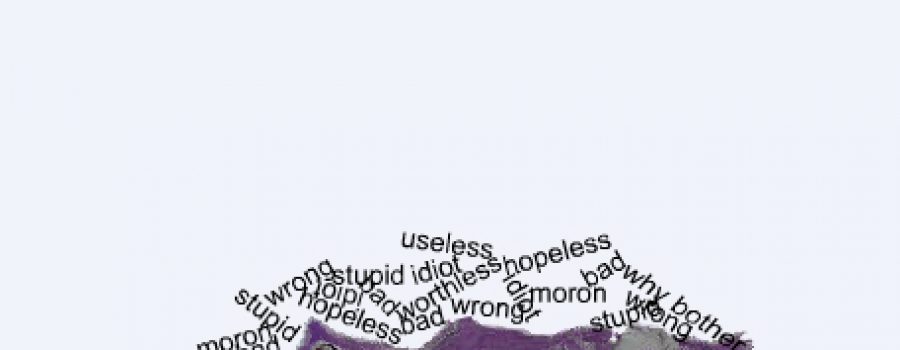“She wants me to leave the learning centre and get a job” the student says perhaps, or to her friends maybe she is angrier: “That b—- wants me to quit school, she doesn’t think I’m worth bothering with!” While the teacher tells her colleague that she spoke to the student to encourage her to “lift her thinking about her abilities. If she wants to work, she has the skills.” These different understandings of the meaning of the teacher’s words, by J, and about her, in Linno’s post, have led me to muse about the stories we tell!
Many of us can be felled by some small comment: a few critical words, or words of concern, or feedback. All may be intended to be constructive, an attempt to help. But the self-talk begins, adding more and more weight to that little comment—the initial “trip” on something hard, like the images shown here—then the feelings of bad and wrong land heavily on us!
When I showed this animation at an adult literacy workshop I listened to a deluge of stories. Each student there was convinced they were the only ones who felt so strongly when they heard, or even imagined, criticism! They were all startled to hear others too felt bad, wrong, stupid, and certain they didn’t belong in that class, that program, or that job! I am disturbed by the certainty we so often have that our interpretation of another’s actions, words, or even inaction or silence, is right, that the story we are spinning is the “truth.”
I can hear Mary, an adult literacy student who died many years ago now, yet still I can feel her fury at people with “big papers” she was sure were judging her, even when they didn’t say a word! She knew her therapist thought she was worthless just from the certificates that lined the woman’s office walls. I remember suggesting those certificates might be on display to show that the therapist had studied how to be a support for Mary, and others. But Mary “heard” only that this therapist believed that with no high school education, Mary was worth nothing. Often people with “big papers” touched that tender place in Mary, likely without even realizing it, but nevertheless leaving her feeling bruised by their words or actions.
It was a long time before I understood that those “judgements” Mary heard bothered her so much because she secretly believed they might be right! A strange contradiction this, because it was her doubt about herself that led her to be so certain about what others were thinking about her. She didn’t ask, she didn’t imagine other plausible stories about why a teacher had said what they did, or what her social worker, or therapist really meant by their actions, she knew! But then I catch myself getting caught up in certainties about others’ judgements too, it’s a very easy slippery slide, even silence can wither us on the spot, until we feel small, immobilized, unable to move forward, or learn! In this era of email overload, silence is too common a response to tentative requests, and the stories of being intentionally ignored we can grow as we wait, can easily drag us down!
When I first began to explore these issues of violence, trauma, and neglect and their impact on learning, I wanted no student to feel stupid, as I had too often as a child, or as I heard so often from Mary. I wanted to declare violence impacts learning from the rooftops! Mary and I began writing about our work together long ago and for nearly 30 years now I’ve been looking at how these impacts play out and what everyone in any role can do that can make a difference to support learning.
I’ve learned many things that can make a difference. I have learned that even the most sensitive teacher, counsellor, or anyone else we cross paths with, can leave us feeling bad. So now I see a starting place is if we all, whatever our location in the learning interaction, whether in the centre or on the sidelines, understand that these big reactions will happen, and try to avoid shame and blame, as much as we can! Once we acknowledge they are there, that they are simply self-protection, that nobody is bad or wrong, the challenge is to find ways to interrupt and reshape them to be more helpful now! Each of us will find different ways that work for us, and for those we seek to support, whether our students, clients, or employees, friends, family, or colleagues. But having some possibilities can help us find our own tools!
I, for example, need to take a total break: read a novel for a few minutes for instance; or do something I feel skilled at, to feel a sense of success, of efficacy; or connect with someone, to laugh together with kindness at my over-the-top reaction! A friend and colleague gave me a reminder that sits above my desk, if I can only remember to look up, it helps me feel connected! I may need to try several options, then, sometimes, I can push the certainty away, knowing it for an old reaction, believe it a little less, and may be move on!
And you? Do you have an array of ideas of what you, your students and others, might try in order to step away from the slippery slope, to shake the certainty of bad, wrong, stupid, don’t belong – to open to learning again as soon as possible?
Note: Drawings above are part of an animation created by Elaine Sayoko Yoneoka, from learningandviolence.net – to be found in the Helping Myself Learn section.









